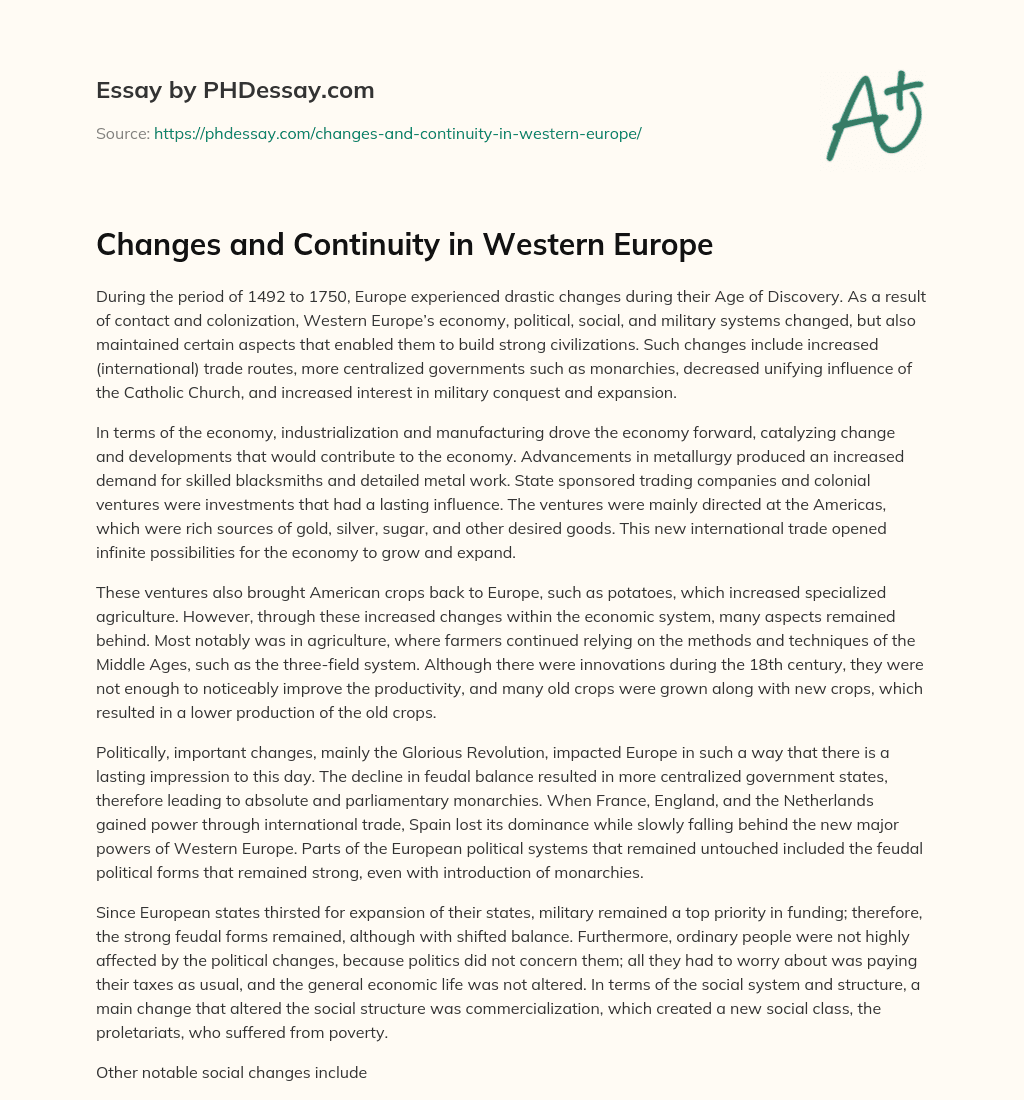Continuities in Western Europe 300ce to 1450
During the period of 1492 to 1750, Europe experienced drastic changes during their Age of Discovery. As a result of contact and colonization, Western Europe's economy, political, social, and military systems changed, but also maintained certain aspects that enabled them to build strong civilizations. Such changes include increased (international) trade routes, more centralized governments such as monarchies, decreased unifying influence of the Catholic Church, and increased interest in military conquest and expansion.
In terms of the economy, industrialization and manufacturing drove the economy forward, catalyzing change and developments that would contribute to the economy. Advancements in metallurgy produced an increased demand for skilled blacksmiths and detailed metal work. State sponsored trading companies and colonial ventures were investments that had a lasting influence. The ventures were mainly directed at the Americas, which were rich sources of gold, silver, sugar, and other desired goods. This new international trade opened infinite possibilities for the economy to grow and expand.
These ventures also brought American crops back to Europe, such as potatoes, which increased specialized agriculture. However, through these increased changes within the economic system, many aspects remained behind. Most notably was in agriculture, where farmers continued relying on the methods and techniques of the Middle Ages, such as the three-field system. Although there were innovations during the 18th century, they were not enough to noticeably improve the productivity, and many old crops were grown along with new crops, which resulted in a lower production of the old crops.
Order custom essay Changes and Continuity in Western Europe with free plagiarism report
GET ORIGINAL PAPER
Politically, important changes, mainly the Glorious Revolution, impacted Europe in such a way that there is a lasting impression to this day. The decline in feudal balance resulted in more centralized government states, therefore leading to absolute and parliamentary monarchies. When France, England, and the Netherlands gained power through international trade, Spain lost its dominance while slowly falling behind the new major powers of Western Europe. Parts of the European political systems that remained untouched included the feudal political forms that remained strong, even with introduction of monarchies.
Since European states thirsted for expansion of their states, military remained a top priority in funding; therefore, the strong feudal forms remained, although with shifted balance. Furthermore, ordinary people were not highly affected by the political changes, because politics did not concern them; all they had to worry about was paying their taxes as usual, and the general economic life was not altered. In terms of the social system and structure, a main change that altered the social structure was commercialization, which created a new social class, the proletariats, who suffered from poverty.
Other notable social changes include the emergence of a European-style family, which emphasized the nuclear family structure, and intensified links between family and individual property, and the decline of influence of the Catholic Church, which cause a separation of peoples' religious and daily lives. However, women maintained their low statuses as inferiors to men, and have fewer alternatives when Protestants abolished convents. In addition, although the Catholic Church lost its influence, the elite remained powerful and limited cultural movements, mirroring that of the Dark Ages but to a lesser extent because of the Enlightenment.
Militarily, the main advancements were evident in the navy, and skills in building stronger, bigger ships capable of sailing the Atlantic and Indian Oceans. The increased interest in military conquest supported state-sponsored expeditions and ventures. France formed a professional military, and Italy became more militarized, with majority of Western European states improving their navies. Similar to their ancestors, the European states used their dominating armies and navies to expand their boundaries and conquer neighbouring lands.
The coastal states gained more territory as a result of having superior naval forces, notably Britain. Throughout the period of 15th to 18th centuries, the changes that occurred, heavily influenced the development of the states into independent, dominating forces with Western Europeans gaining their own unique identity. Although there were more changes than continuities, the aspects that did last through this period aided in the development of others, such as how the feudal political forms aided the emerging monarchies in becoming stronger, lasting till modern day.
Europe's Age of Discovery was a time for drastic and rapid changes, changes for the best, and not necessarily for the worst. Guns, Germs, and Steel. Dir. Jerad Diamond. National Geographic, 2005. DVD. Hoffman, Philip T. "Prices, the Military Revolution, and Western Europe's Comparative Advantage in Violence. " Economic History Review, Feb2011 Supplement. Vol. 64. 2011. 39. Print. "Outline. " World Civilizations, AP Edition. Pearson Education, 2010. Web. 11 Dec. 2011. . "Transformation of the West. " World Civilizations. Pearson Education, 2010. Web. 11 Dec. 2011. .

Did you know that we have over 70,000 essays on 3,000 topics in our database?
Cite this page
Explore how the human body functions as one unit in harmony in order to life
banfieldalwaroullace.blogspot.com
Source: https://phdessay.com/changes-and-continuity-in-western-europe/